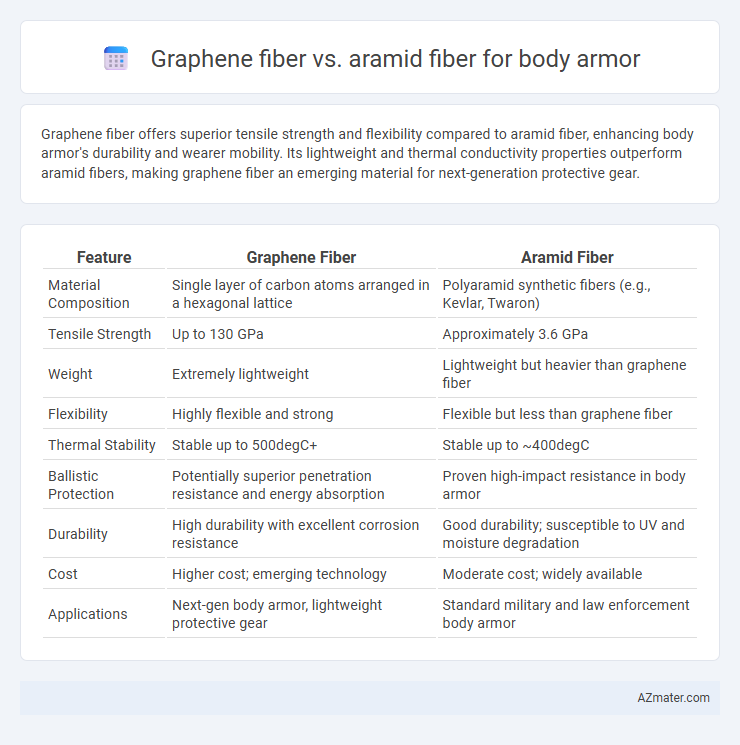Graphene fiber offers superior tensile strength and flexibility compared to aramid fiber, enhancing body armor's durability and wearer mobility. Its lightweight and thermal conductivity properties outperform aramid fibers, making graphene fiber an emerging material for next-generation protective gear.
Table of Comparison
| Feature | Graphene Fiber | Aramid Fiber |
|---|---|---|
| Material Composition | Single layer of carbon atoms arranged in a hexagonal lattice | Polyaramid synthetic fibers (e.g., Kevlar, Twaron) |
| Tensile Strength | Up to 130 GPa | Approximately 3.6 GPa |
| Weight | Extremely lightweight | Lightweight but heavier than graphene fiber |
| Flexibility | Highly flexible and strong | Flexible but less than graphene fiber |
| Thermal Stability | Stable up to 500degC+ | Stable up to ~400degC |
| Ballistic Protection | Potentially superior penetration resistance and energy absorption | Proven high-impact resistance in body armor |
| Durability | High durability with excellent corrosion resistance | Good durability; susceptible to UV and moisture degradation |
| Cost | Higher cost; emerging technology | Moderate cost; widely available |
| Applications | Next-gen body armor, lightweight protective gear | Standard military and law enforcement body armor |
Introduction to Advanced Fibers in Body Armor
Graphene fiber offers exceptional tensile strength and lightweight properties, making it a cutting-edge material for body armor applications. Aramid fiber, such as Kevlar, has long been a standard due to its high strength-to-weight ratio and proven ballistic resistance. The integration of advanced fibers like graphene and aramid enhances the durability, flexibility, and protective capabilities of modern body armor systems.
What is Graphene Fiber?
Graphene fiber is a cutting-edge material composed of graphene sheets bonded into a lightweight, highly durable fiber known for exceptional tensile strength and flexibility, making it ideal for advanced body armor. Unlike aramid fiber, which is a synthetic polymer like Kevlar with excellent heat resistance and impact absorption, graphene fiber offers superior electrical conductivity and thermal management properties. The unique atomic lattice structure of graphene fiber enhances ballistic protection while reducing overall armor weight, presenting a technological advantage in flexible body armor applications.
What is Aramid Fiber?
Aramid fiber is a class of heat-resistant and strong synthetic fibers commonly used in body armor due to their exceptional tensile strength and durability. Brands like Kevlar and Twaron, made from aramid fibers, provide reliable ballistic protection while maintaining lightweight flexibility essential for wearable armor. Compared to graphene fiber, aramid fibers have a longer history of proven effectiveness in resisting impacts and penetration in ballistic applications.
Mechanical Strength Comparison
Graphene fiber exhibits superior tensile strength, with values exceeding 130 GPa, significantly outperforming Aramid fibers, which typically range between 2.4 to 3.6 GPa. The stiffness of Graphene fiber, measured by its Young's modulus of approximately 1 TPa, provides enhanced impact resistance compared to the 70-120 GPa modulus of Aramid fibers. This remarkable mechanical strength positions Graphene fiber as a revolutionary material in body armor, offering enhanced protection with reduced weight and improved flexibility.
Weight and Flexibility Differences
Graphene fiber offers superior flexibility and significantly lighter weight compared to Aramid fiber, enhancing wearer comfort and mobility in body armor applications. While Aramid fibers like Kevlar provide excellent ballistic resistance, their denser structure results in heavier, stiffer armor. The advanced molecular composition of graphene fibers allows for lightweight, flexible armor systems without compromising strength or protection levels.
Ballistic Protection Capabilities
Graphene fiber offers exceptional tensile strength and flexibility, enhancing ballistic protection by dissipating impact energy more effectively than traditional materials. Aramid fiber, such as Kevlar, is widely used in body armor for its high tensile strength, lightweight nature, and proven ability to absorb and disperse ballistic impacts. While graphene fiber shows potential for superior energy absorption and multi-hit resistance, aramid fiber remains the industry standard due to established performance, cost-efficiency, and availability in current ballistic protection applications.
Durability and Environmental Resistance
Graphene fiber exhibits superior durability in body armor applications due to its exceptional tensile strength and resistance to wear, surpassing traditional aramid fibers like Kevlar. Graphene's exceptional environmental resistance includes high tolerance to moisture, UV radiation, and temperature fluctuations, whereas aramid fibers degrade more rapidly under prolonged environmental exposure. The combination of graphene fiber's robustness and stability ensures enhanced longevity and consistent protective performance in diverse environmental conditions compared to aramid-based materials.
Cost and Manufacturing Considerations
Graphene fiber offers superior strength-to-weight ratio and enhanced flexibility compared to aramid fiber, but its high production costs and complex synthesis processes currently limit widespread adoption in body armor manufacturing. Aramid fiber remains more cost-effective due to established large-scale production methods and lower raw material expenses, making it the preferred choice for budget-sensitive defense applications. Manufacturing graphene fiber-based armor requires advanced technologies and longer production times, increasing overall costs versus the mature, streamlined fabrication of aramid fiber composites.
Future Trends in Body Armor Development
Graphene fiber offers unprecedented strength-to-weight ratios and enhanced flexibility compared to traditional aramid fibers such as Kevlar, promising lighter and more durable body armor solutions. Ongoing research focuses on integrating graphene-based composites to improve impact resistance and thermal management in protective gear. Future trends indicate a shift toward hybrid materials combining graphene fibers with aramid layers to maximize ballistic protection while reducing wearer fatigue.
Conclusion: Choosing the Optimal Fiber
Graphene fiber offers exceptional tensile strength and lightweight properties, enhancing flexibility and impact resistance in body armor applications. Aramid fiber, known for its proven ballistic performance and heat resistance, remains a reliable choice for protective gear. Selecting the optimal fiber depends on prioritizing either advanced strength-to-weight ratios with graphene or established durability and thermal stability with aramid materials.

Infographic: Graphene fiber vs Aramid fiber for Body armor
 azmater.com
azmater.com